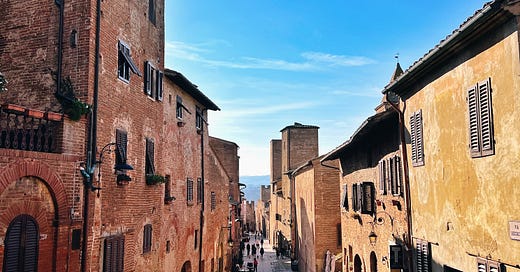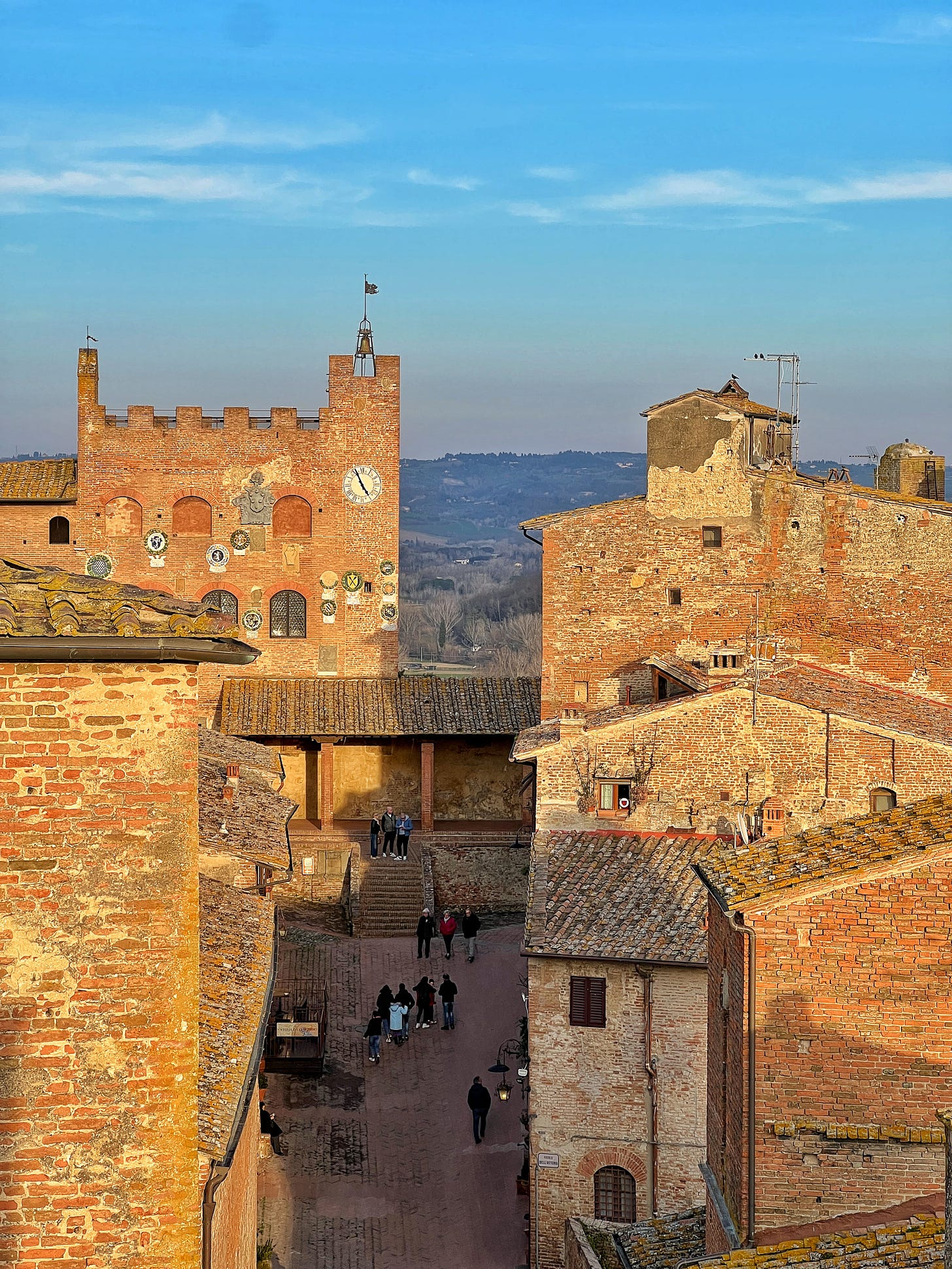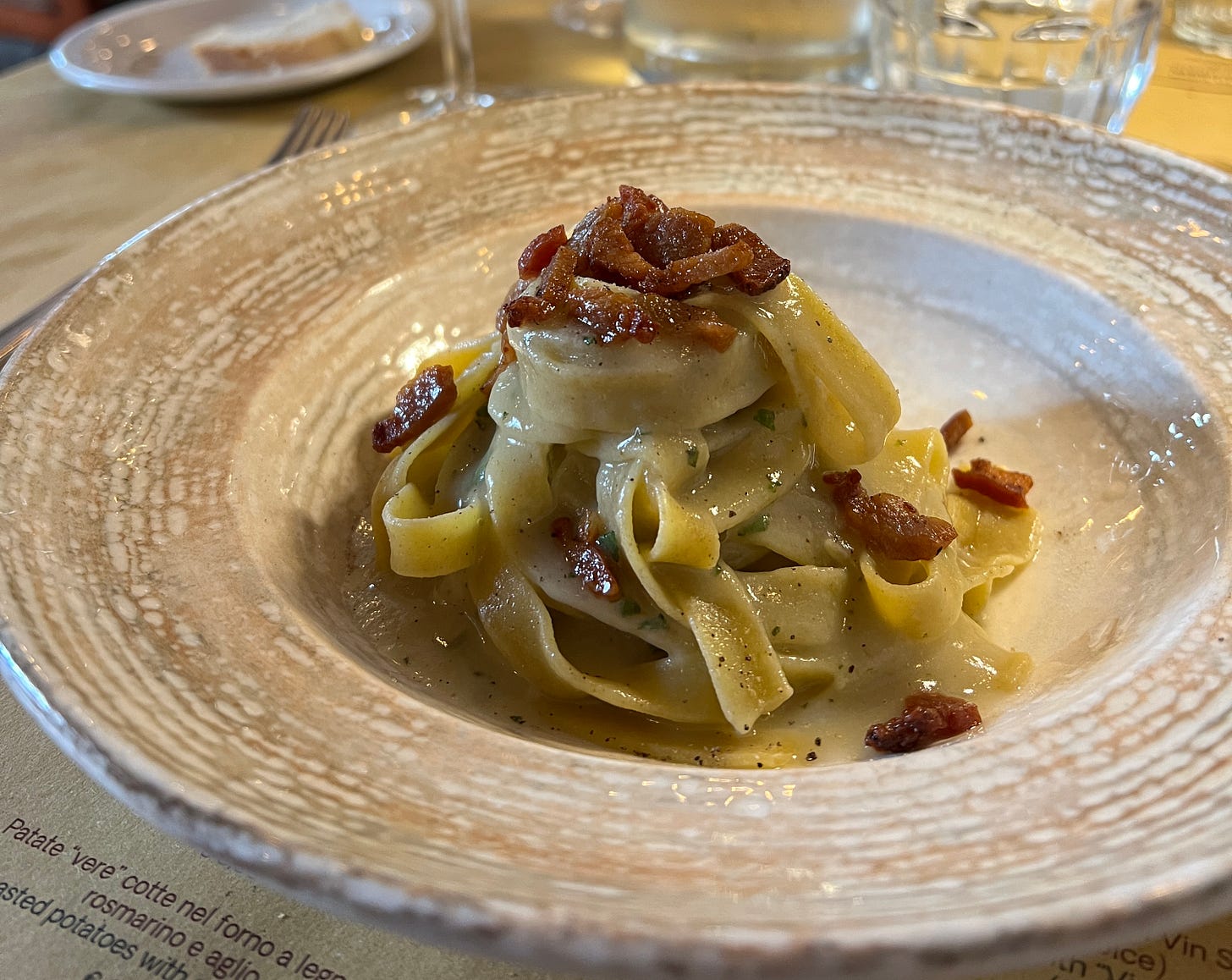Today's newsletter is a little different than usual. I'm leaving the floor to
, a friend, a social media strategist and journalist with a rare talent for writing about her travels. She will take us on a gita fuori porta, an out-of-town trip, sharing a travel itinerary in which art, history, and food are enmeshed with the most beautiful landscapes of the Tuscan hills.If you like it—and I know you will—this could become a recurring column on Letters from Tuscany, to give you some off-the-beaten-path ideas for your next trip to Tuscany.
I met Paola more than a decade ago, a few days after meeting Tommaso: she has lived in Florence for twenty years, but she is from Puglia, exactly from Oria, a town in Salento that she introduced us to one summer several years ago. Since then, I have deeply appreciated her innate talent for telling the soul of a place: you could sense it from the way she told us about her village life, interspersing stories with postcard views, glimpses of daily life, walks in the stone alleys, and a dinner at a local restaurant that I still remember.
Whether it's Iceland, Paris, Namibia, or Trieste, she manages to see things that elude most, and combines her passion for street art with her passion for photography exhibitions, gardens, museums, books, and restaurants. I've recommended her IG stories on Paris to more than one person, and I've made endless notes about trips I may someday take. But in the meantime, I enjoy her stories, because Paola with a few words manages to sketch the soul of a place and its contradictions. She shares what is worth seeing and eating, unusual excursions, lesser-known museums, the unexpected events that make each trip memorable, without ever leaving out the funniest sides as well.
What is most surprising, though, is the way she chronicles her weekly gite fuori porta, out-of-town trips, days spent discovering Medici villas, castles, medieval villages, exhibitions and trattorias, all within easy reach of Florence. I asked her if she wanted to share one of her out-of-town trips with us, and so today we will follow Paola’s lead to Certaldo.
You can read Paola’s Newsletter on Substack In Viaggio con Cosmopablita (in Italian) or follow her on Instagram as @cosmopablita.
Link Love:
If you want to read more about Certaldo, you can also follow
here on Substack with her newsletter . She lives in Certaldo and she is a connoisseur of its beautiful market.- was in Tuscany in March, and Judy took him around. Here he recommends an excellent ice cream shop in Certaldo.
If you have our previous cookbook, From the Markets of Tuscany, you will find a chapter on Certaldo’s market, with tips on where to go, and a recipe for Certaldo onion jam.
An out-of-town trip to Certaldo
The amazing thing about living in Tuscany for more than two decades is always being able to find some unknown place to fall in love with. Far from the most renowned destinations, it is easy to come across villages, castles, mansions that still bear the mark of the incredible history of this region and preserve a quietness that is now hard to find. This is what I sensed on my last out-of-town trip to discover Certaldo, the village at the center of the Val d'Elsa, most famous for being home to Giovanni Boccaccio1.
The most charming thing about Certaldo is that you literally feel catapulted into the Middle Ages: once you get off the funicular railway that allows you to reach Certaldo Alta, you feel embraced by this village with its red bricks, ancient slabs of stone on the ground, and deep silence. In Certaldo Alta, in fact, you will hardly see a car pass by, as access to the center is reserved exclusively for residents. That is why your mind immediately races to imagine what life was like in the 14th century: you are walking through a town that has remained identical to how it developed in the Middle Ages. Who doesn't love time travel?
What to See
Walk down the wide Via Boccaccio with Palazzo Pretorio at the end drawing you in like a magnet. You will notice that there is no real square, because life was all taking place here on this street in the center of the town. If it is a sunny day, lift your gaze to appreciate the contrast between the red walls and the blue sky. Walk by Stiozzi Ridolfi Palace and then Giannozzi Palace, peek through a series of side alleys and small inner courtyards, pass Casa Boccaccio until you find yourself in front of it, Palazzo Pretorio, which is definitely worth a visit.
From 1415 to 1784 it was the seat of the Vicariate, which administered mainly criminal justice: here you will enter the civil prisons that still bear the ancient graffiti of prisoners on the walls, the rooms used for torture and those in which prisoners awaited judgment. If below you feel all the suffering of this place, the upper floor instead takes you back to the pageantry of the great ceremonies: it was in these rooms that the Vicar celebrated his ceremonies, and today they instead house contemporary artworks that wonderfully share the stage with ancient frescoes by Pier Francesco Fiorentino.
One last unmissable treat: on the ground floor, behind a small door, you will find a part of the old vegetable garden transformed by artist Hidetoshi Nagasawa into a Japanese garden with a wooden teahouse, a place of extreme quiet in which two cultures so distant in space and time are able to converse.
The 5-euro ticket to Palazzo Pretorio also includes a visit to the Casa Boccaccio museum. Don't expect something particularly exciting because this building, which housed Boccaccio until his death, was actually renovated in the early 19th century and then almost razed to the ground during World War II, but it is worth seeing especially because it is home to the Ente Nazionale Boccaccio and houses a beautiful library all centered on the Decameron: here you will discover many translations (even in Japanese) and especially versions illustrated by renowned artists as Chagall and Dalì.
And then the grand finale: by climbing the highest tower you will enjoy a unique view of all of Certaldo Alta and its surrounding hills.
What to Eat - Three Addresses for you
Certaldo is famous for its onion, a slow food presidium, a symbol present since the XIV century in the city's coat of arms. Our gastronomic itinerary will be completely in the name of this magnificent product.











